LG G4 Review
The LG G4 retains a familiar look and still packs a removable battery and microSD slot, but it receives several internal upgrades, including a Snapdragon 808 SoC, an all-new camera, and a QHD IPS Quantum Display.
Why you can trust Tom's Hardware
Camera Performance And Photo Quality
The spec sheet for the G4’s camera reads like a wish list: 16 MP sensor, OIS, laser autofocus, f/1.8 aperture lens, color spectrum sensor. Now it’s time to see if all this technology delivers excellent photos or leaves us wishing for more.
All of the images shown below were taken using the Auto mode unless noted. Also, you can view the full-sized image for each photo by clicking the text links below the images that are within a slideshow album. The LG G4 and Galaxy S6 both use a 16:9 aspect ratio, where the LG G3 and iPhone 6 Plus shoot natively with a 4:3 aspect ratio. The HTC One M9 uses an unusual 10:7 aspect ratio.
Outdoors
Daylight
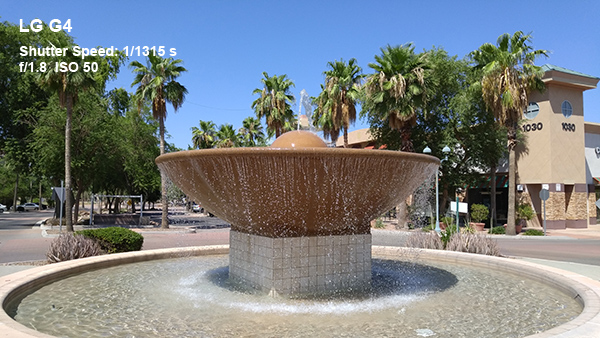
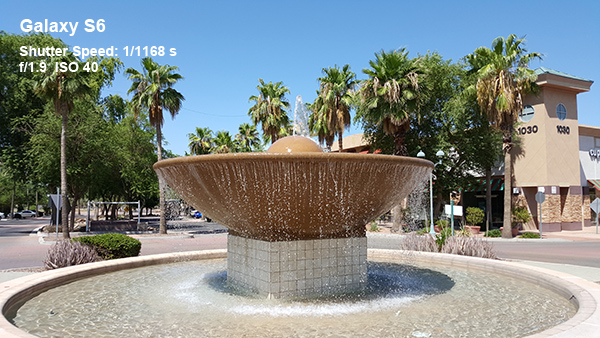
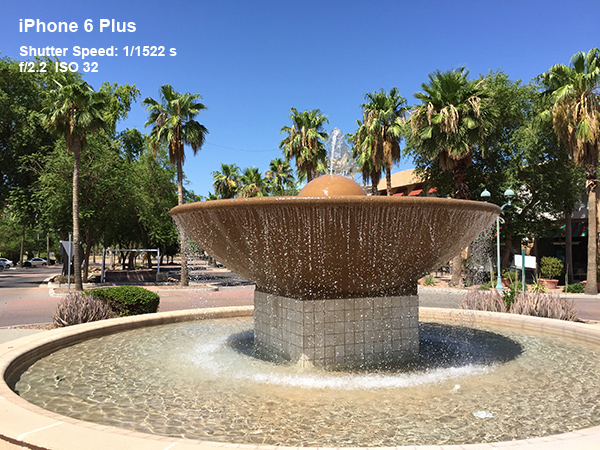
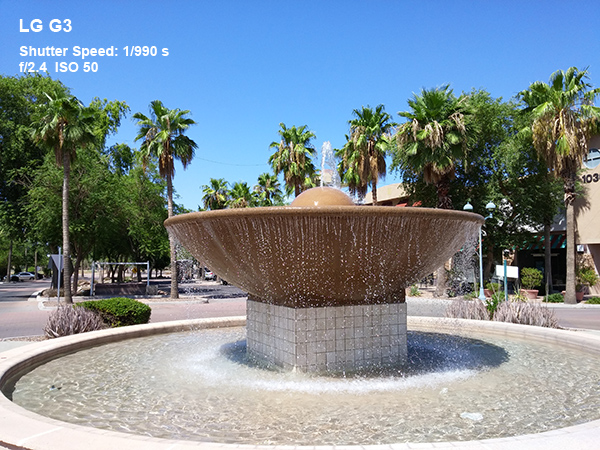
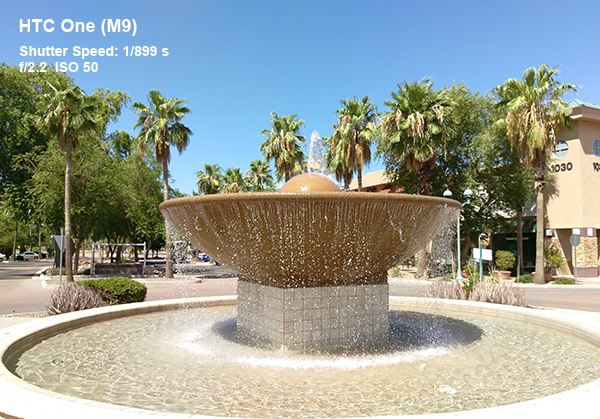
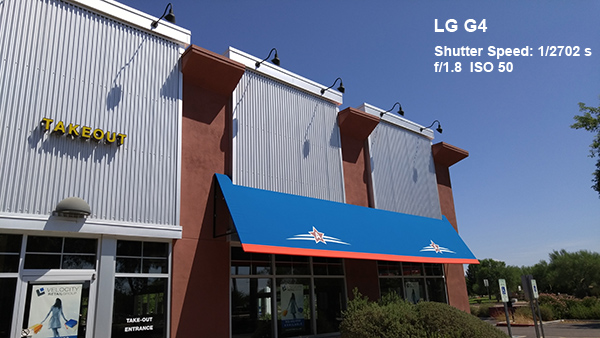
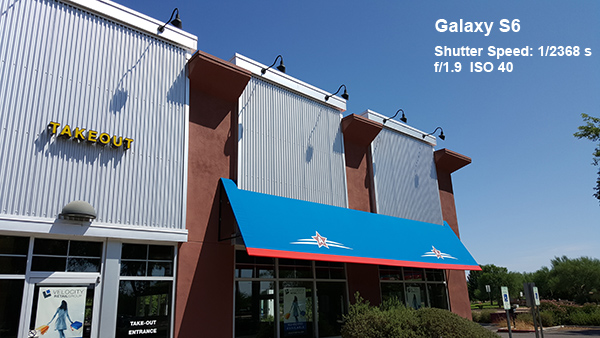
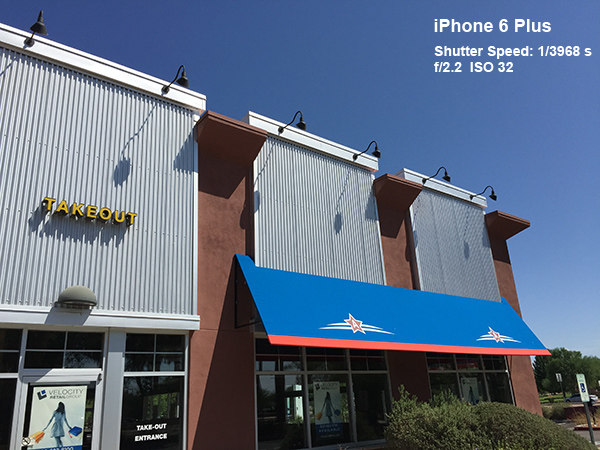
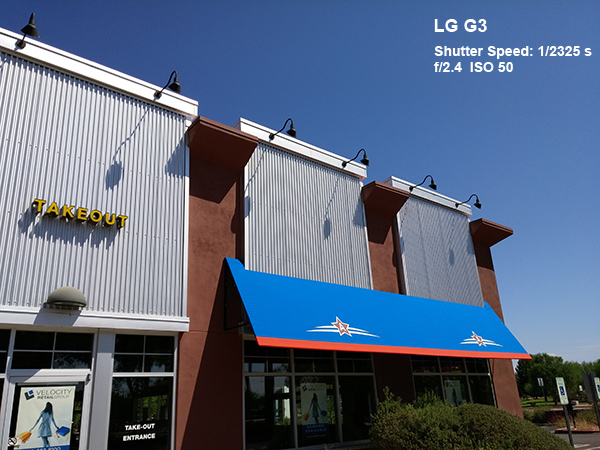
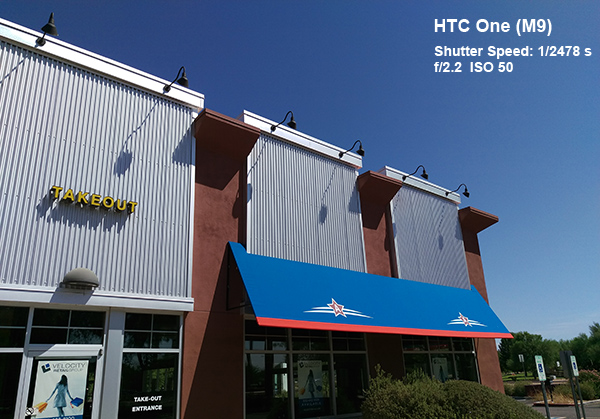
Full-Size Images: [LG G4: daylight fountain], [Galaxy S6: daylight fountain], [iPhone 6 Plus: daylight fountain], [LG G3: daylight fountain], [HTC One M9: daylight fountain], [LG G4: daylight restaurant], [Galaxy S6: daylight restaurant], [iPhone 6 Plus: daylight restaurant], [LG G3: daylight restaurant], [HTC One M9: daylight restaurant]
The Galaxy S6 with Sony IMX240 Exmor RS sensor produces the best image in our first daylight scene with the fountain. It gets the exposure correct and white balance perfect, nailing the tone of the blue sky, green trees, and tan building. The image is sharp and noise is virtually nonexistent.
While not perfect, the LG G4 also does well. Its image is a little dark, but colors look good after accounting for the luminance deficit. There’s a little bit of noise in the sky and building, placing the G4 just behind the S6 here.
The G4 does better than the remaining phones, however. The white balance for the iPhone’s image is a little too warm (the extra red content makes the sky look purple) and is also a little too dark. The G3’s image looks pretty good, but it has more noise than the G4 and iPhone 6 Plus. HTC’s One M9 proves no contest for the G4 in this scene. It’s image is overexposed, losing almost all of the brick detail around the fountain. There’s also some purple tint in the corners of the sky. This appears to be a post-processing artifact rather than an optical aberration, since this effect is not consistent from one scene to the next.
Get Tom's Hardware's best news and in-depth reviews, straight to your inbox.
In the second scene, showing the side of a restaurant, the Galaxy S6 produces the best picture once again. It’s bright without being overexposed and white balance is accurate. There is some slight purple fringing along the boundary between the silver walls and sky, though.
Just like in the first scene, the LG G4 comes in a close second to the S6. The G4’s image is slightly underexposed again and the white balance skews slightly warm. Image noise is similar to what we see from the S6, but there’s a hint of edge softening from the noise reduction algorithm. The images from the G3, iPhone 6 Plus, and M9 all exhibit more noise than the G4.
Evening
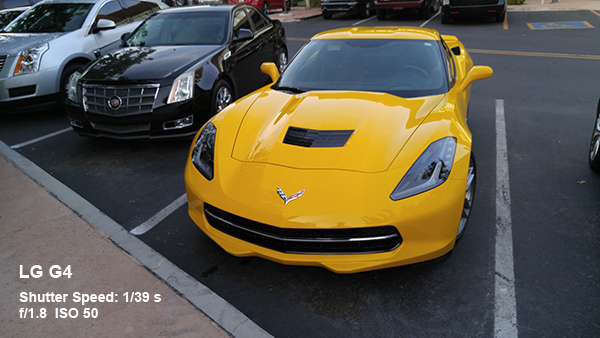
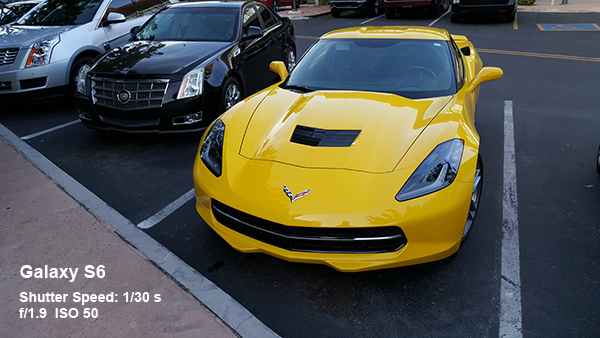
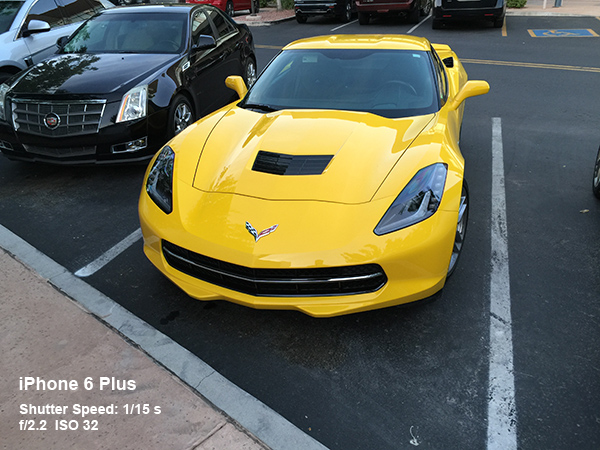
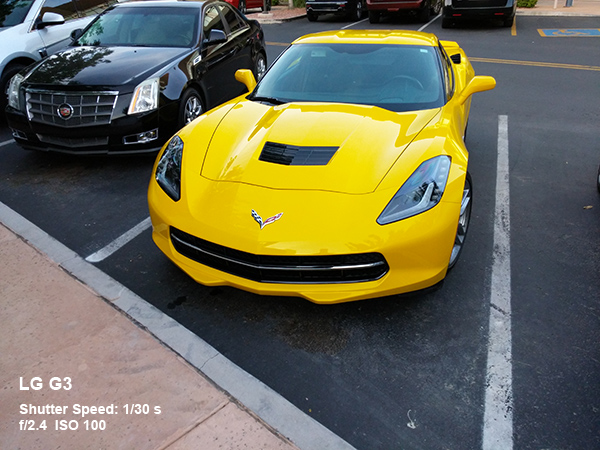
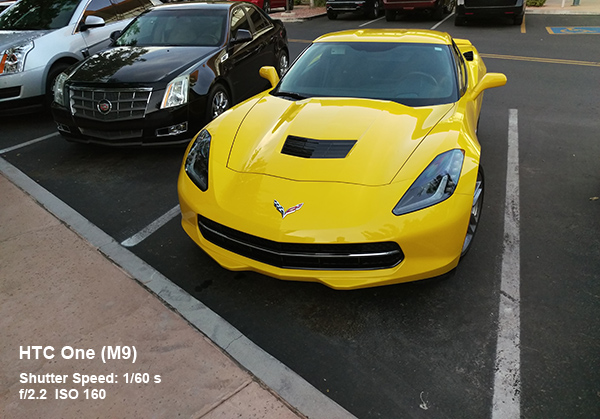
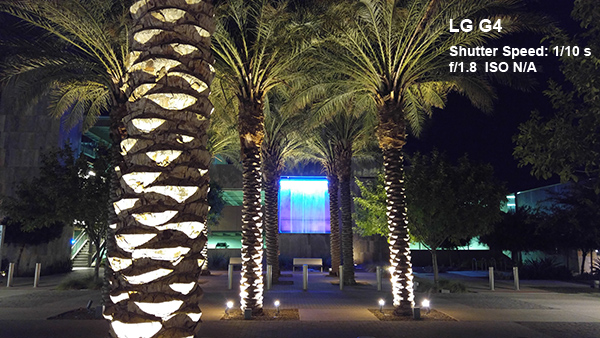
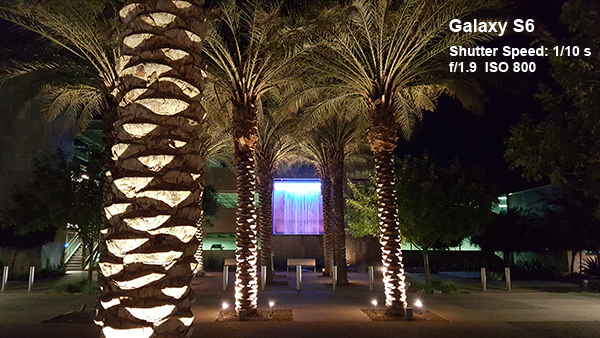
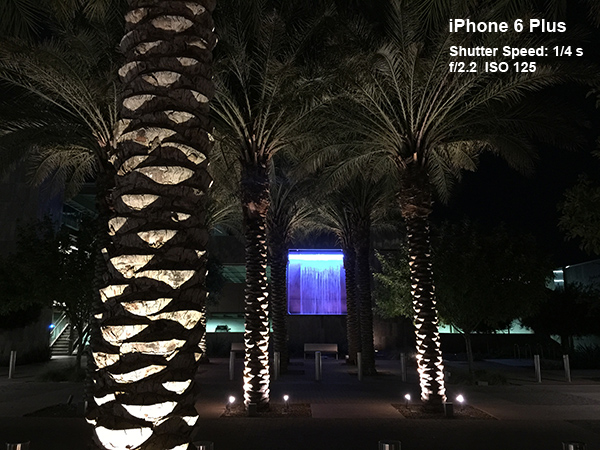
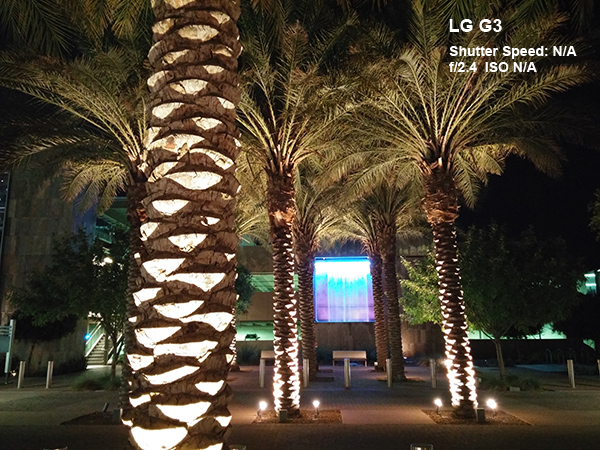
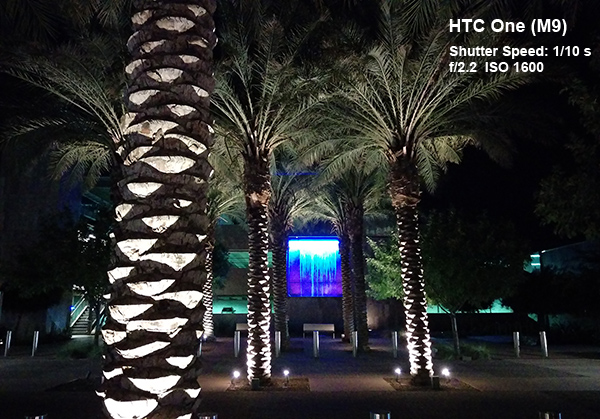
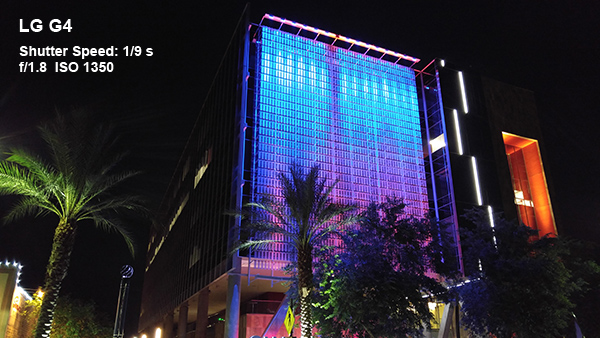

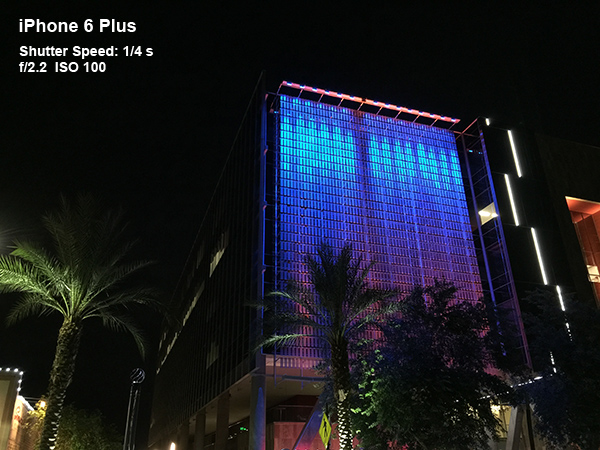
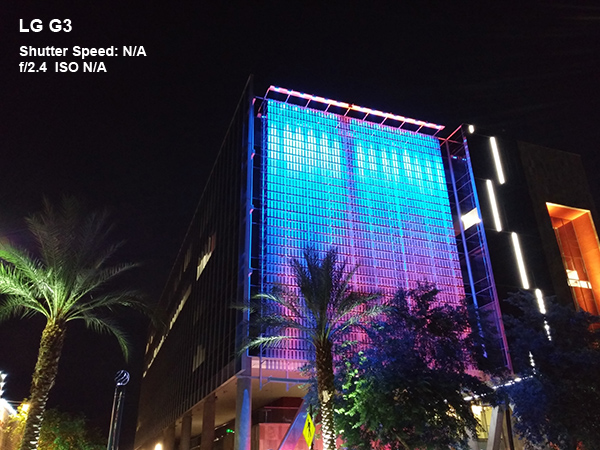
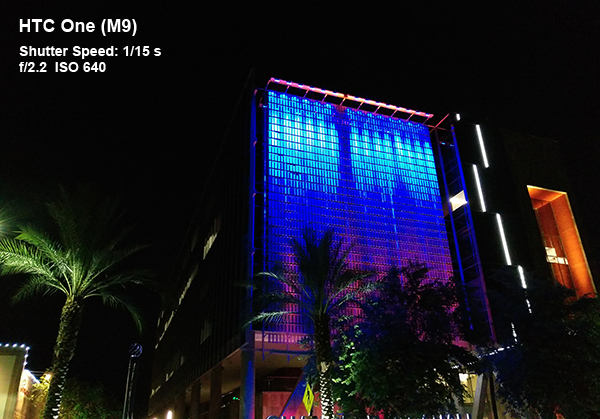
Full-Size Images: [LG G4: dusk Corvette], [Galaxy S6: dusk Corvette], [iPhone 6 Plus: dusk Corvette], [LG G3: dusk Corvette], [HTC One M9: dusk Corvette], [LG G4: night waterfall], [Galaxy S6: night waterfall], [iPhone 6 Plus: night waterfall], [LG G3: night waterfall], [HTC One M9: night waterfall], [LG G4: night building], [Galaxy S6: night building], [iPhone 6 Plus: night building], [LG G3: night building], [HTC One M9: night building]
The pictures of the Corvette were shot just before sunset in the shade of a building, a difficult scenario for getting exposure and white balance correct. Indeed, we do see more variation from camera to camera here than in the daylight images. The M9 gives the yellow paint on the car a green tint. The G3 produces a nice, bright image, but the yellow on the Corvette and the yellow stripes on the road look oversaturated. It also exhibits more noise than the iPhone 6 Plus and a hint of edge softening from noise reduction. Both the Galaxy S6 and the iPhone 6 Plus deliver the best images but for different reasons. The Galaxy S6 again shows almost no noise with very sharp detail. Colors are close, but its image is just a little dark. Leaving its shutter open twice as long helps the iPhone 6 Plus create a brighter image, and it captures the colors perfectly. The G4 falls behind the S6 and iPhone 6 Plus, creating an image that’s too warm (the Corvette is more of a mustard yellow instead of a bright yellow like it should be) and sharpness suffers because of noise reduction. Unlike the phase detection AF used by the S6 and iPhone, the G4’s laser/contrast AF combo fails in this scenario. We took four different pictures of the Corvette with the G4, and all of them are blurry.
The next series of images, showing the palm trees in front of the waterfall, were taken after dark and show even greater variation. The Galaxy S6, G4, and G3 all produce bright looking images (albeit unnaturally bright) free of any camera-shake induced blurring thanks to OIS. Taking a different path, the iPhone 6 Plus uses the longest exposure, but instead of increasing brightness, it drives down ISO to 125—the lowest value of the group—keeping image noise low. Raising ISO to 1600, the M9’s noisy image is reduced to a blurry mess in post-processing by extremely aggressive noise reduction. It also struggles with dynamic range: The shadows are too dark, and the highlights on the trees and waterfall are overexposed.
While this call is more subjective, we feel that the S6 and G4 create the best images in this scene. The S6 produces a bright image without exaggerating the tree and waterfall highlights as much as the G3 and G4. Its colors are accurate and background detail remains sharp. The G4’s colors are a little off (the trees are too green) and it lacks the warmth shown in the S6 image. However, the G4’s noise smoothing algorithm does a great job here, resulting in far less visible noise than the S6 and without losing detail or sharpness (look at the staircase on the left side as an example).
In the second night scene showing the building, we see more of the same from each phone. Despite having to raise ISO to 1350, the G4’s image exhibits less visible noise than all of the others, making it the best performer in low-light situations.
HDR
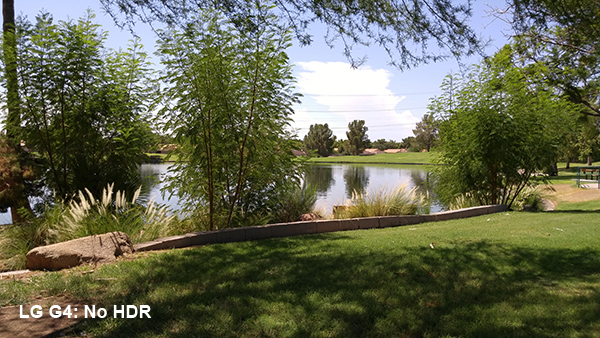
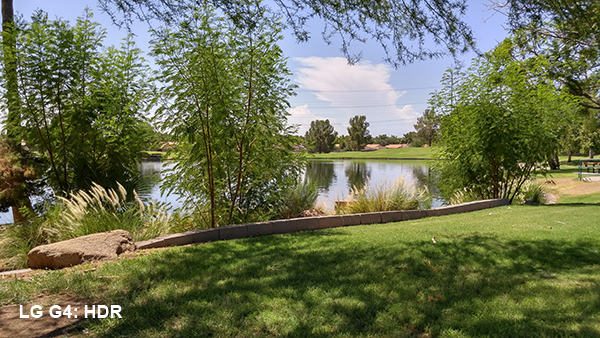
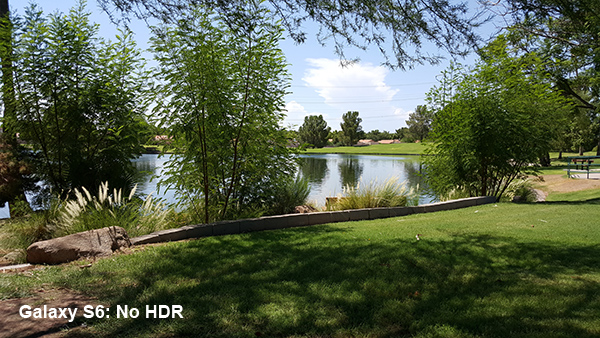
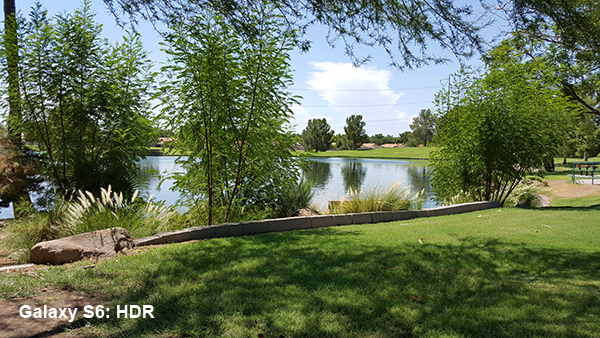
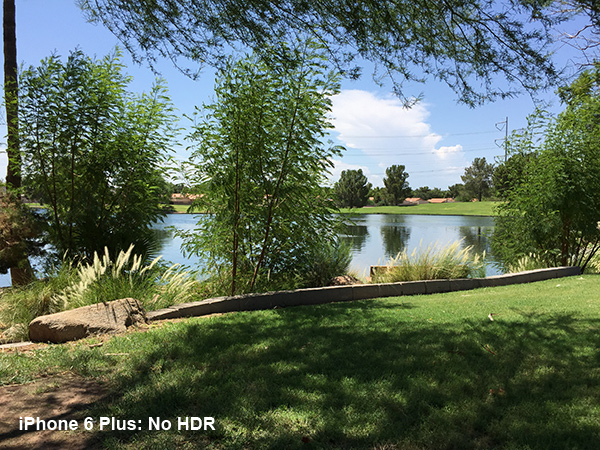
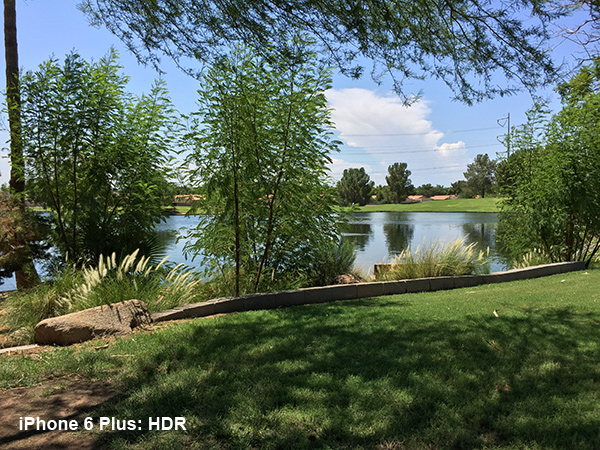
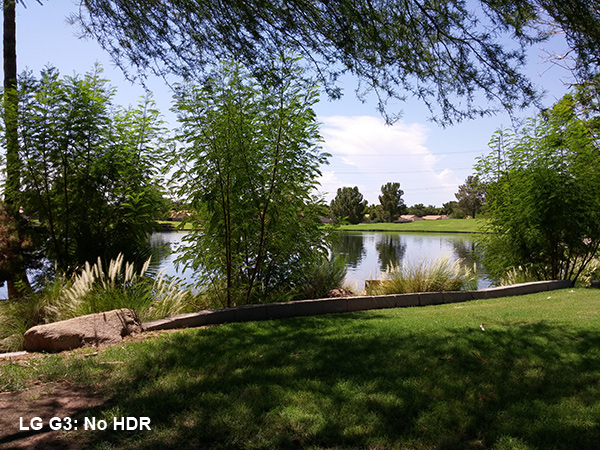
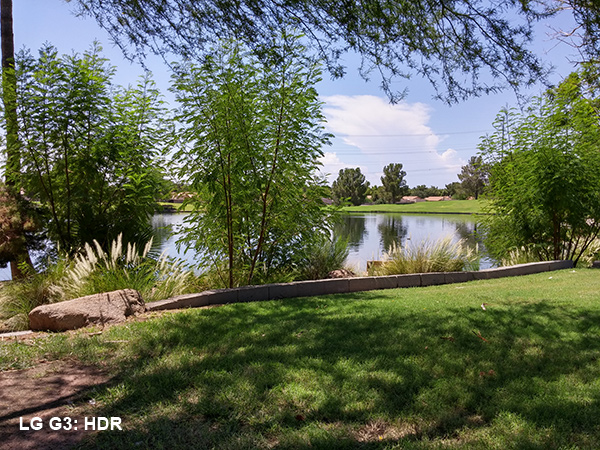

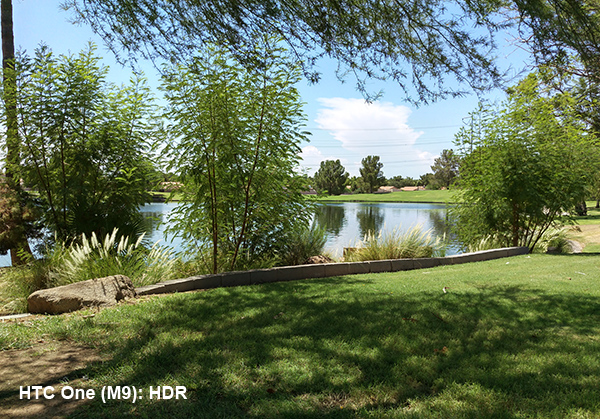
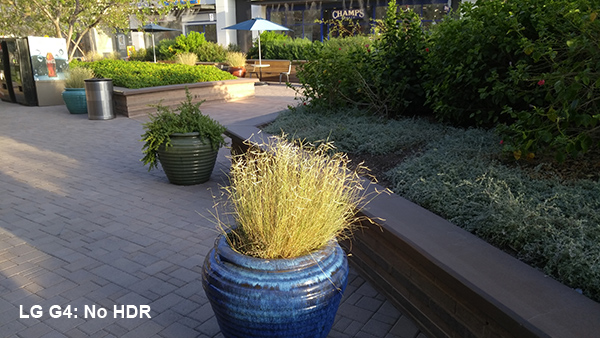
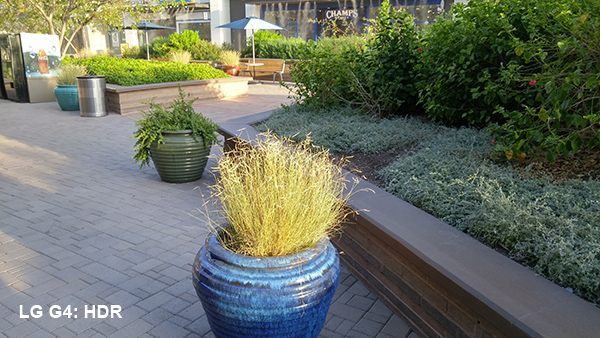
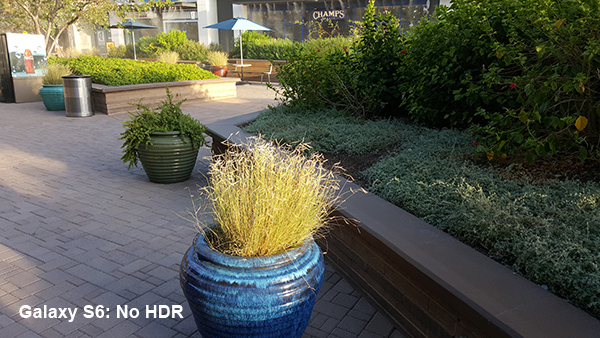
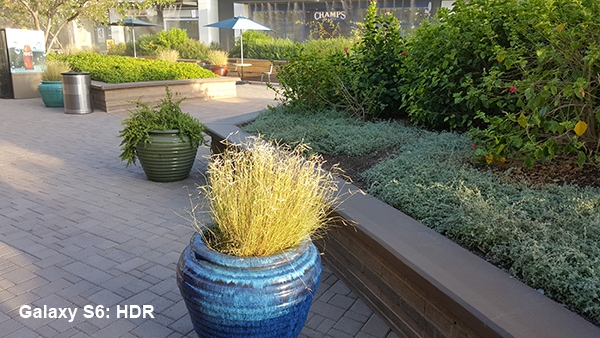
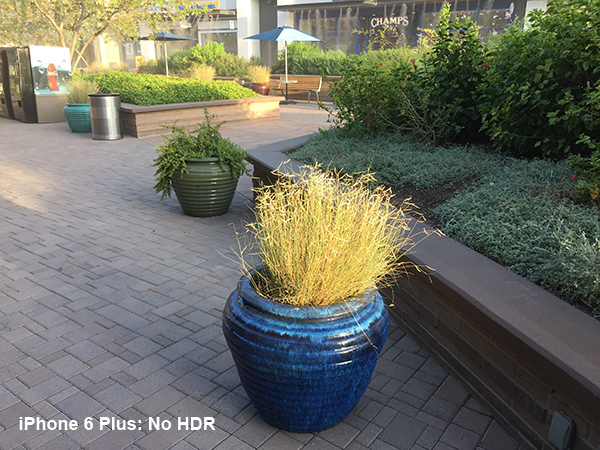
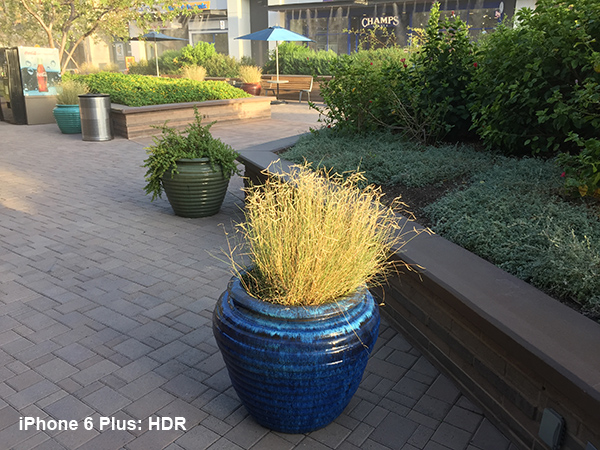
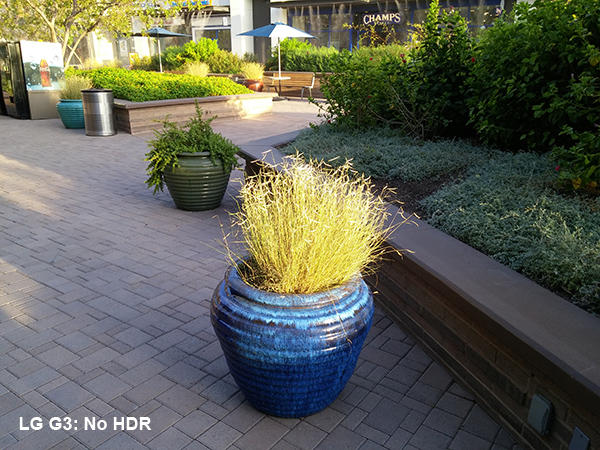
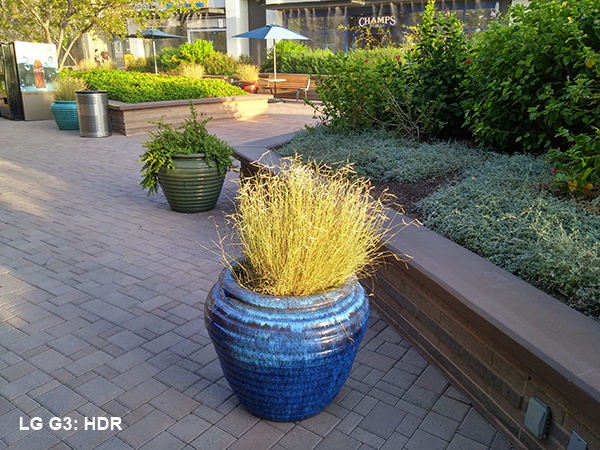
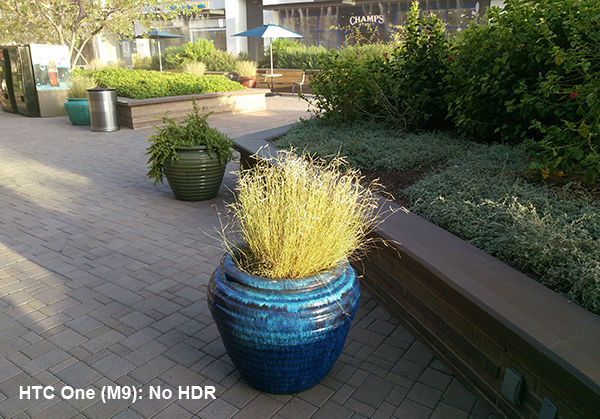
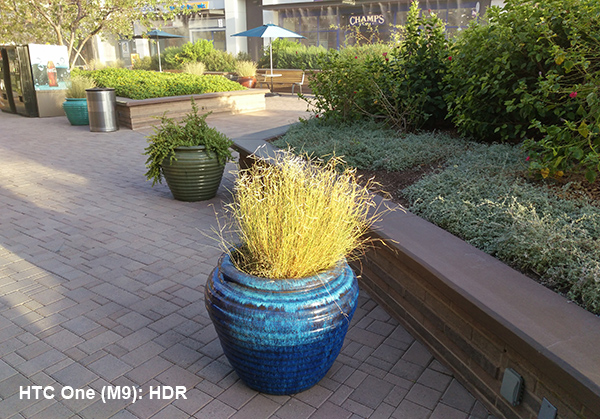
Full-Size Images: [LG G4: lake - no HDR], [LG G4: lake - HDR], [Galaxy S6: lake - no HDR], [Galaxy S6: lake - HDR], [iPhone 6 Plus: lake - no HDR], [iPhone 6 Plus: lake - HDR], [LG G3: lake - no HDR], [LG G3: lake - HDR], [HTC One M9: lake - no HDR], [HTC One M9: lake - HDR], [LG G4: courtyard - no HDR], [LG G4: courtyard - HDR], [Galaxy S6: courtyard - no HDR], [Galaxy S6: courtyard - HDR], [iPhone 6 Plus: courtyard - no HDR], [iPhone 6 Plus: courtyard - HDR], [LG G3: courtyard - no HDR], [LG G3: courtyard - HDR], [HTC One M9: courtyard - no HDR], [HTC One M9: courtyard - HDR]
Because digital cameras have limited dynamic range, a good HDR mode is essential. In the first set of images looking out across the lake, we see some subtle differences in how HDR is applied. The M9, for example, just brightens the entire image, which actually works ok in this case. It also captures the color of the sky better by shifting the white point. In contrast, HDR mode on the iPhone 6 Plus does not brighten the shadows at all. It tones down the overexposed sky, but it also incorrectly darkens the sunlit grass. The Galaxy S6’s HDR mode effectively brightens the shadows, but leaves the white cloud slightly overexposed. The G4’s HDR mode produces the most dramatic effect, but that’s mainly because of how overexposed the cloud was to begin with. Unfortunately, the white point skews toward red, making the sky in the G4’s image look purple.
The second set of images showing a courtyard were taken just before sunset, so the natural light had a yellow tint. In these conditions, we see the G3’s HDR mode excel. It effectively brightens the darkest areas, while reducing the overexposed highlights on the umbrella and building walls in the background. The colors in the image are also accurate and nicely saturated (HDR processing often produces washed-out images). The G4 does not perform as well here as its predecessor, however. It just brightens the whole image, making the overexposed areas worse. There’s also a small amount of yellow color bleed around the potted reeds in the forefront not present in the other HDR images. The G4 does perform better than the iPhone 6 Plus, which actually makes the shadows darker, and it avoids the white point shift the M9 experiences in HDR mode (the image shifts from having too much green to having too much red).
There’s no clear winner here when it comes to HDR performance, since each phone performs differently as conditions change. The G4 does pretty well, outperforming the M9 and iPhone, but seems to take a step backwards relative to the G3’s HDR mode.
Indoors
The staged indoor shots below were lit by overhead LED lights, a CFL lamp from the front, and an incandescent overhead light in the background.
Bright Light
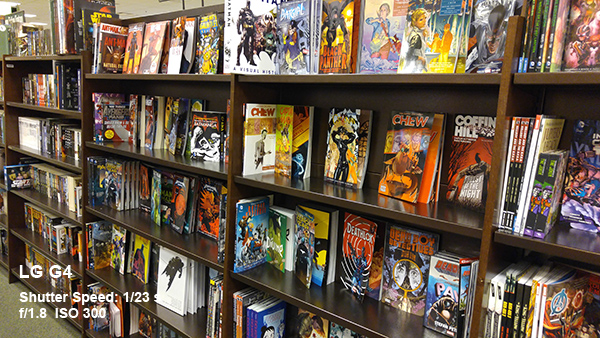
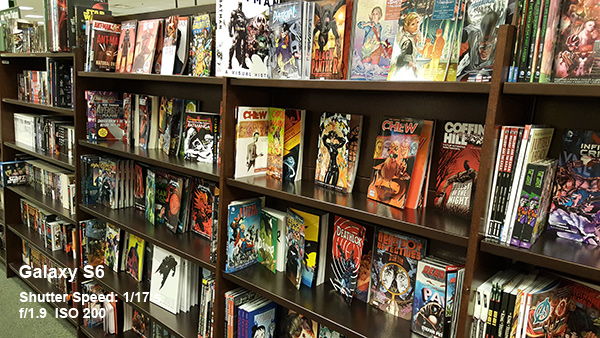
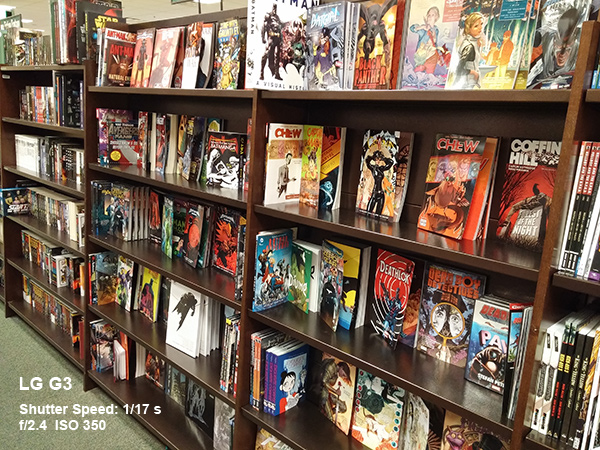
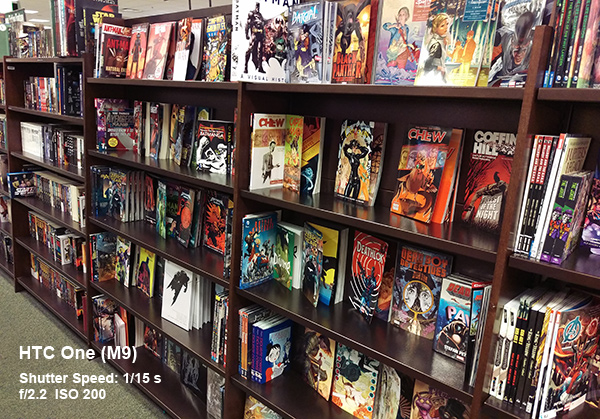
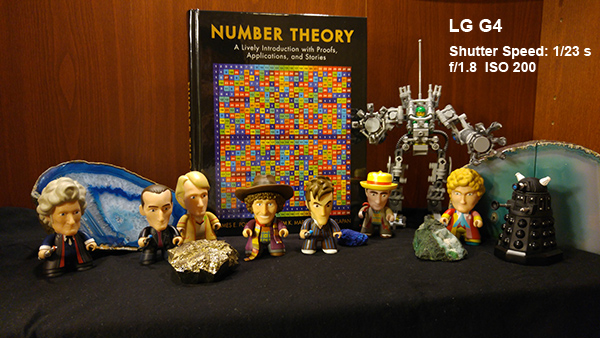
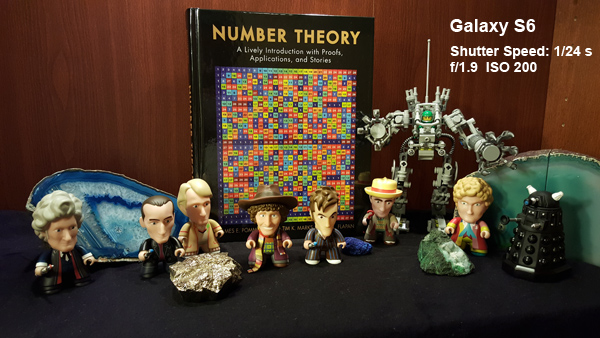
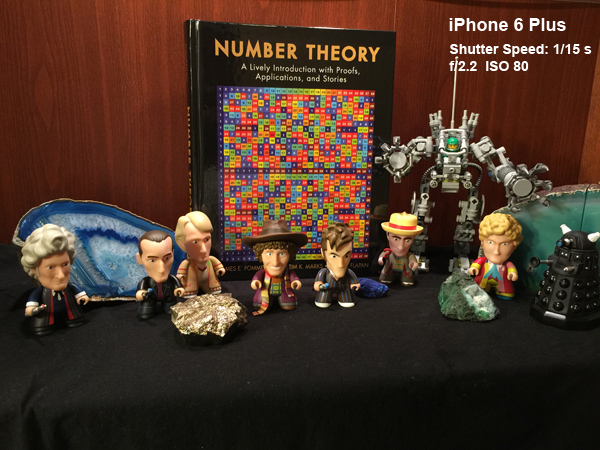
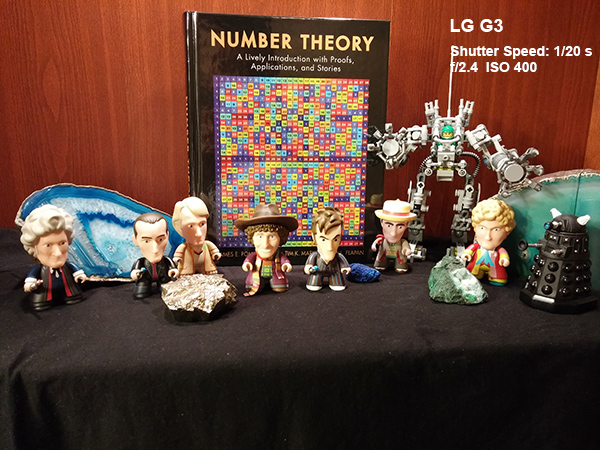
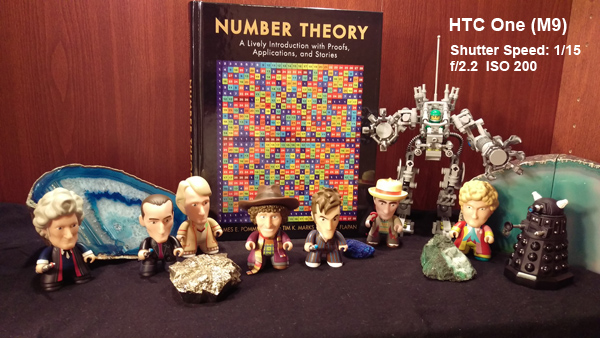
Full-Size Images: [LG G4: indoor bookshelf], [Galaxy S6: indoor bookshelf], [LG G3: indoor bookshelf], [HTC One M9: indoor bookshelf], [LG G4: indoor bright], [Galaxy S6: indoor bright], [iPhone 6 Plus: indoor bright], [LG G3: indoor bright], [HTC One M9: indoor bright]
The first indoor scene of the bookshelf is lit by fluorescent lights, which generally emit light with a strong greenish-yellow component. The Galaxy S6 emphasizes the green component, giving its image a green tint. While not excessive, there’s also some visible noise grain. The white point for both the G3 and G4 skews toward yellow. The G4’s noise reduction algorithm does a great job smoothing out noise grain without destroying texture and detail; the book covers still look very sharp. However, some yellow splotches appear on the bookshelf and ceiling tiles, artifacts of the noise reduction. The M9 tends to use a cooler white point, which helps colors look more neutral in this scene.
In the staged scene, the G3 and the M9 create overly bright images that overexpose faces and highlights on hair and hats. The M9’s auto white balance also does poorly, capturing an image that’s so warm the black fabric looks red. The other three phones set the exposure correctly, but struggle with white balance. The iPhone 6 Plus’ image is a bit too warm, while the S6’s image shows a slight green tint. Worse still is the G4, whose yellowish-green image is less pleasing to the eye.
Low Light and Flash
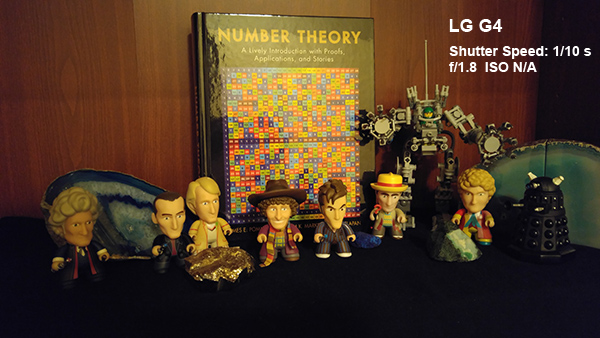
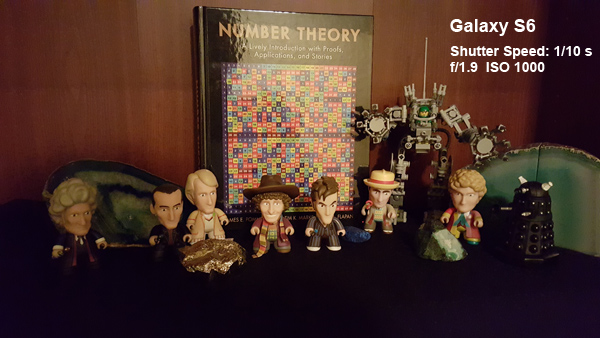
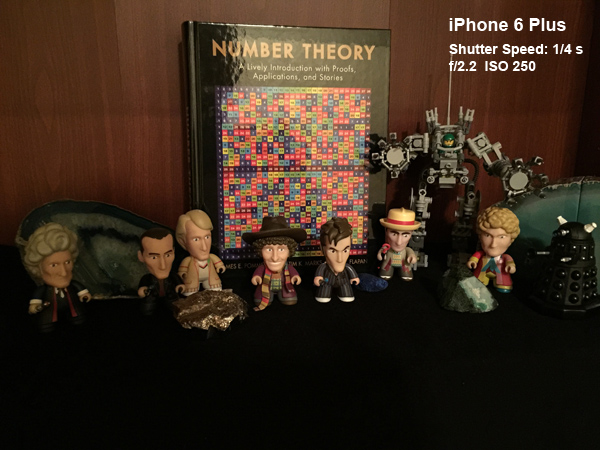
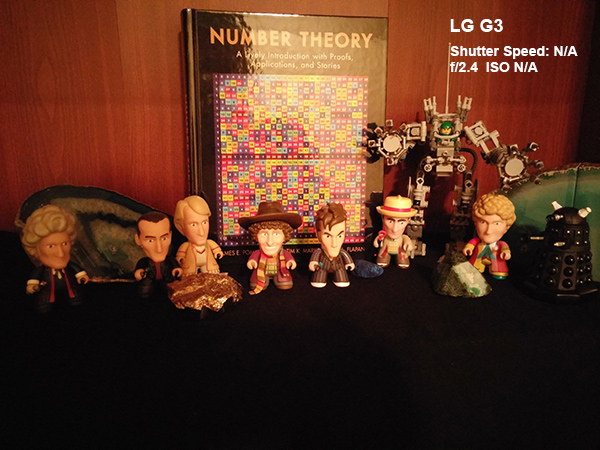
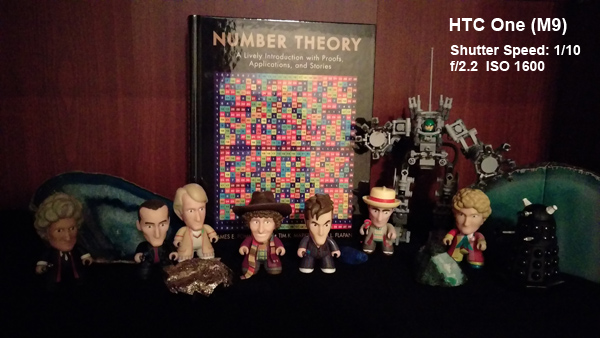
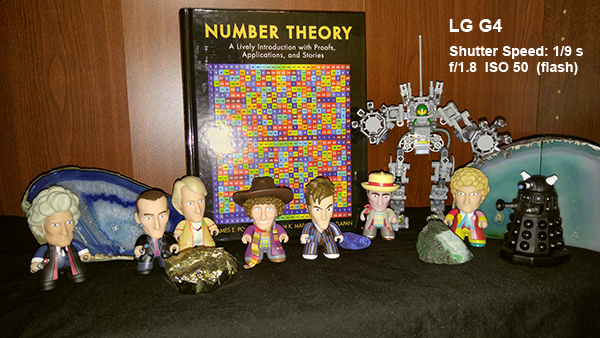
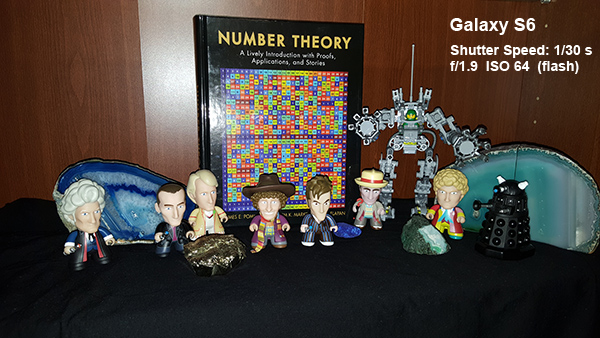
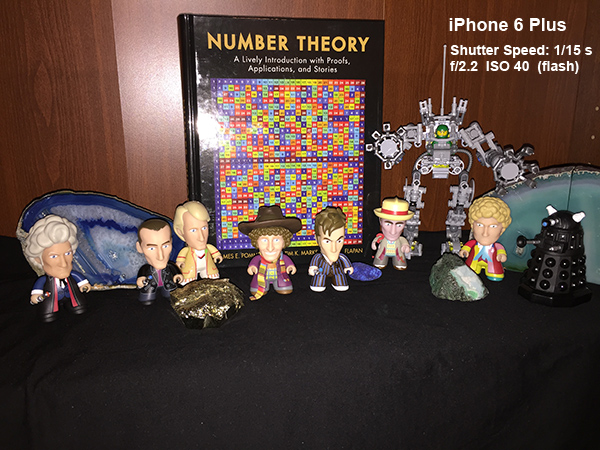
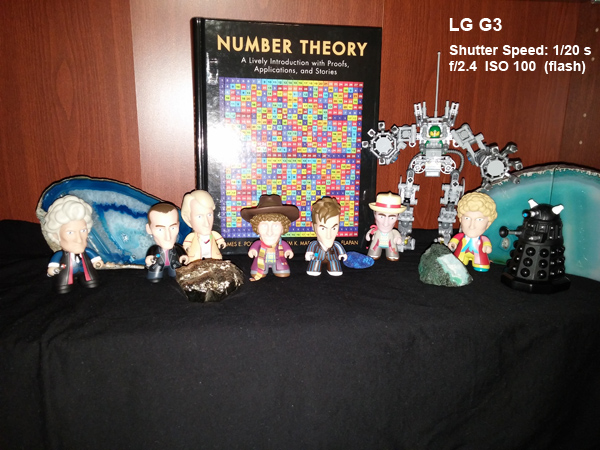
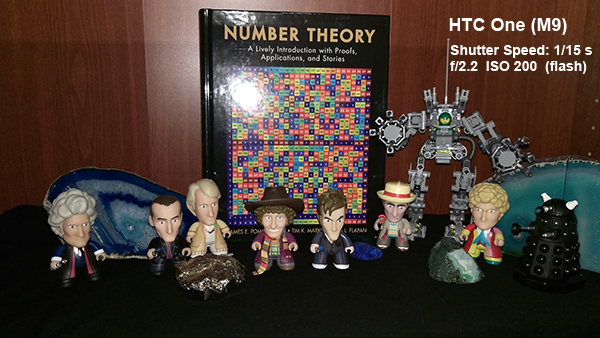
Full-Size Images: [LG G4: indoor dark], [Galaxy S6: indoor dark], [iPhone 6 Plus: indoor dark], [LG G3: indoor dark], [HTC One M9: indoor dark], [LG G4: indoor flash], [Galaxy S6: indoor flash], [iPhone 6 Plus: indoor flash], [LG G3: indoor flash], [HTC One M9: indoor flash]
The low-light scene was only lit by the incandescent light in the background. With very little light to work with, the LG G3 engages its long exposure mode. This does increase brightness but also gives the image a severe red tint. The G4’s image is a substantial improvement, despite its yellowish appearance. Even in this very low-light scenario, there’s almost no discernible noise. The G4’s noise smoothing algorithm is the best we’ve seen, wiping away noise while preserving image detail. The numbers on the book are still sharp, as are the thin lines on the figures’ clothing; even the question marks on the seventh Doctor’s shirt are still visible! The Galaxy S6 and iPhone 6 Plus do a better job setting the white balance and capturing color, but both show more noise than the G4.
Turning the flash on helps the G3’s color accuracy, but it overpowers the scene and overexposes all the faces. The iPhone 6 Plus image is too warm, turning the blue pinstripes on the suit purple. This is a minor offense, though, compared to the M9’s mischievous noise reduction that wipes away the Doctors’ mouths, making his various selves look like members of the Silence!
With the lights out and the flash on, the S6 and G4 shine once again. Both produce nice looking images but for different reasons. White balance in the S6’s image is a bit cool, making the faces look white, but details are very sharp. The G4’s image has a warmer tone, but is a little fuzzier than the S6.
Front-Facing Camera
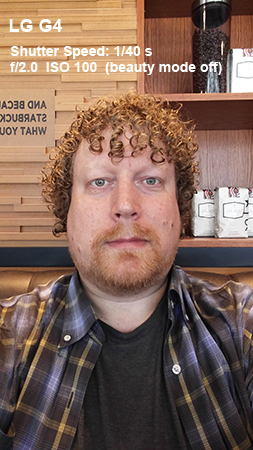
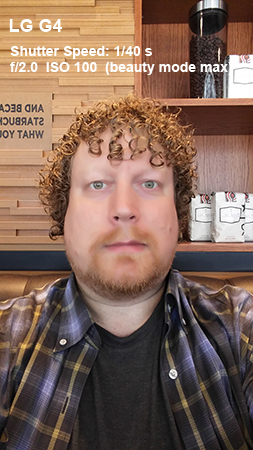
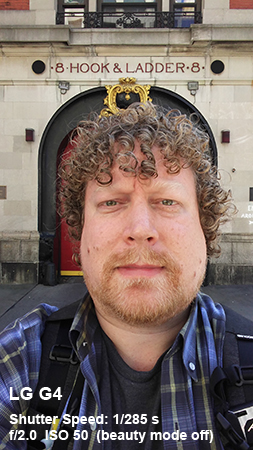
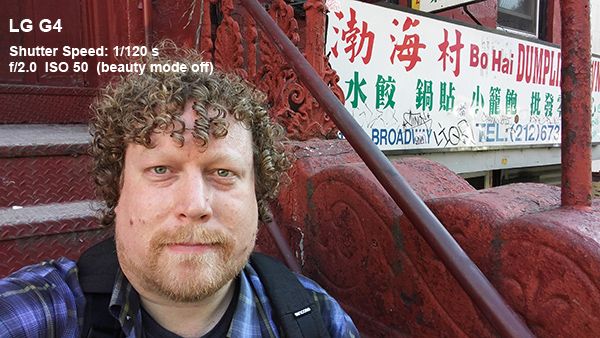
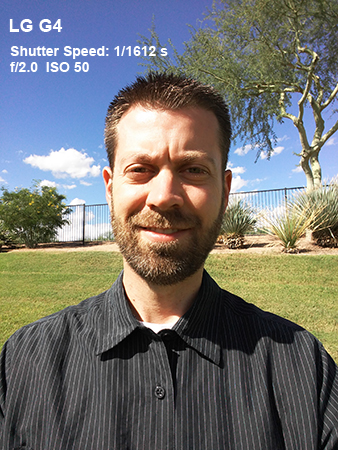
Full-Size Images: [LG G4: front camera indoors - beauty mode off], [LG G4: front camera indoors - beauty mode max], [LG G4: front camera outdoors - overcast 1], [LG G4: front camera outdoors - overcast 2], [LG G4: front camera outdoors - bright sun]
The first two selfies were taken inside a coffee shop and show the effects of using the camera’s beauty mode; it’s turned off in the first image, but is set for maximum effect in the second. The author’s face shows significant smoothing—his mustache looks like it’s penciled on—but the G4’s face detection works well, preserving his beard and hair and leaving the background untouched.
The remaining pictures were taken outdoors during the day. In the first two, the G4 sets the correct exposure and white balance for the shady conditions. The 8 MP sensor captures a lot of detail and the pictures look very sharp. The last image, taken in bright sunlight, also turns out well. The G4 avoids overexposing the clouds and highlights on the author’s face, and the colors are accurate without being oversaturated. There’s a little bit of noise in the sky, and if we want to get picky, the sky shows some purpling around the picture’s border. Overall, the G4’s front-facing camera does an excellent job.
Additional Sample Images
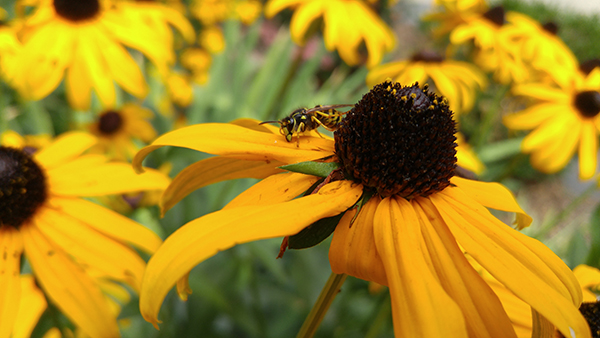
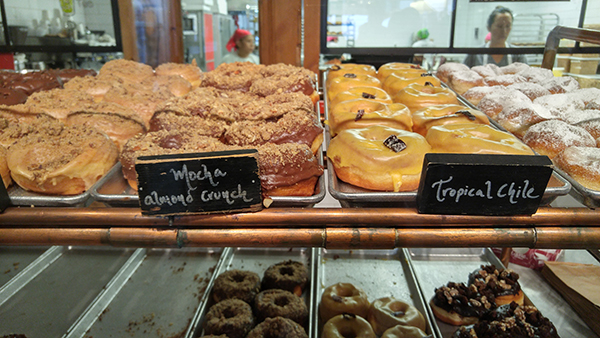
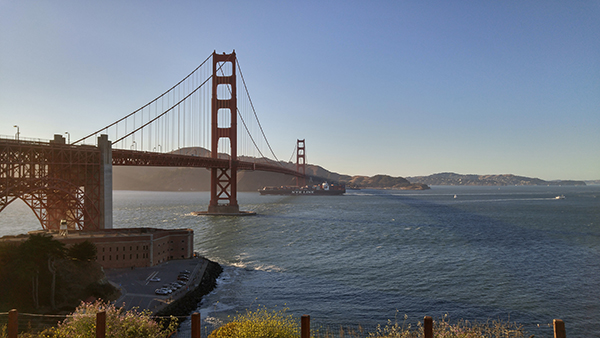
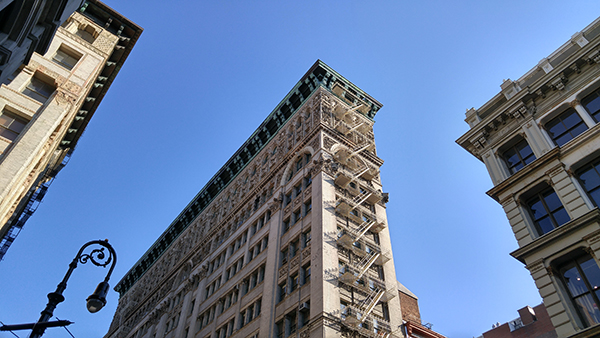
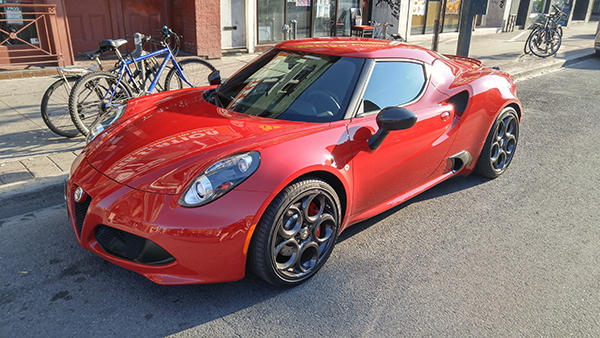
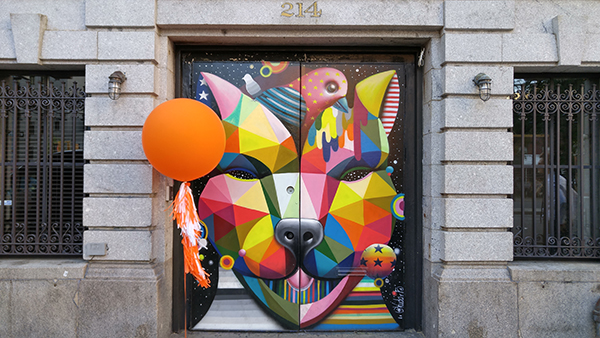
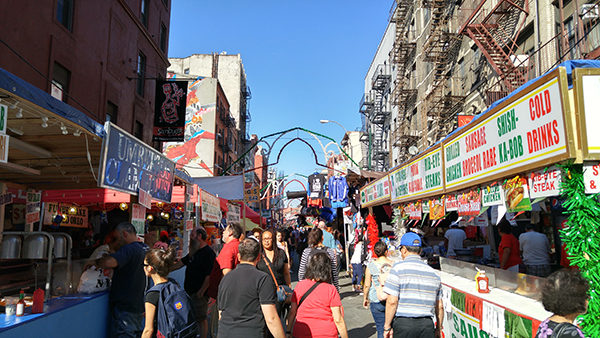

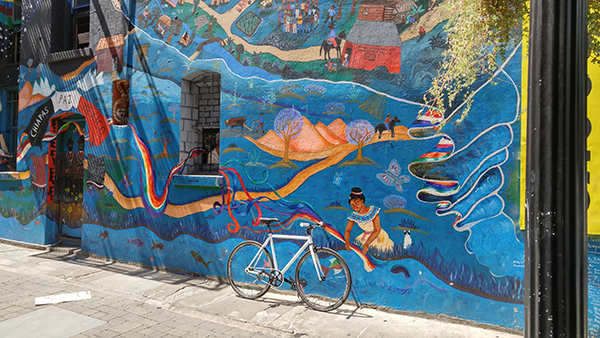
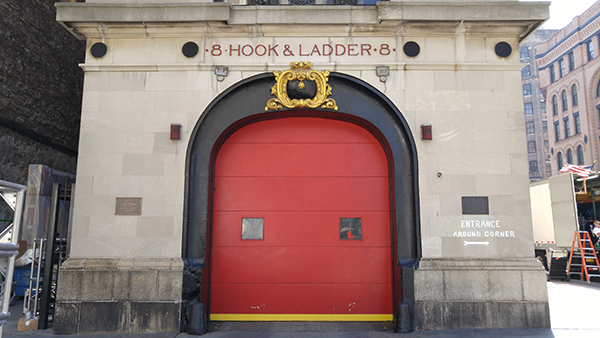


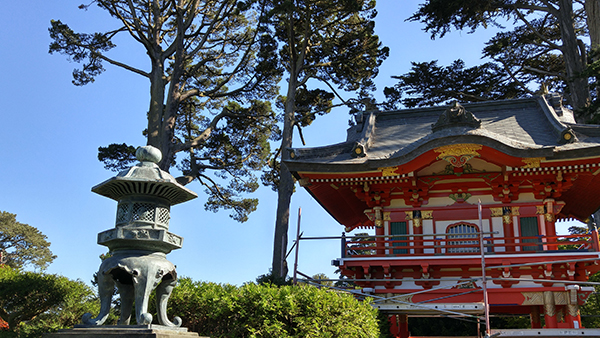
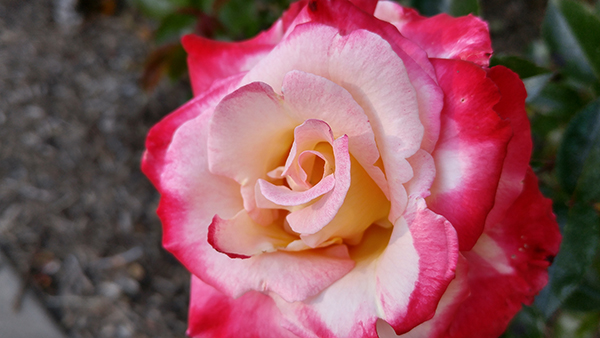
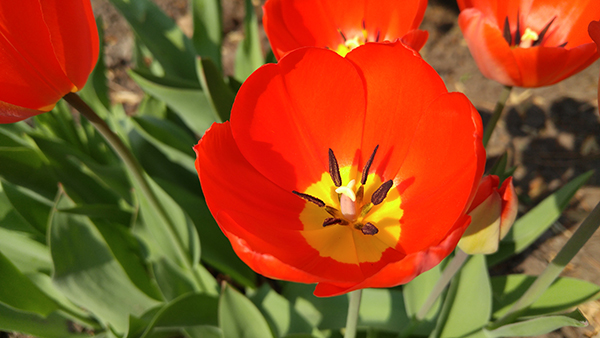
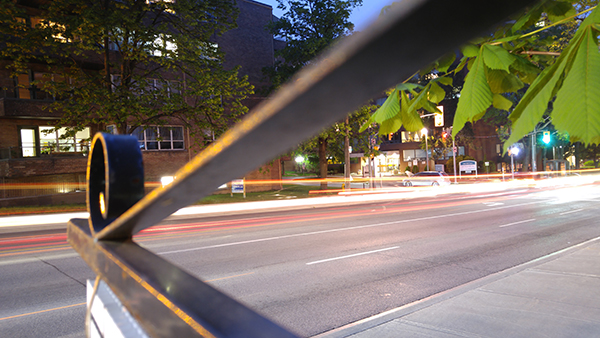


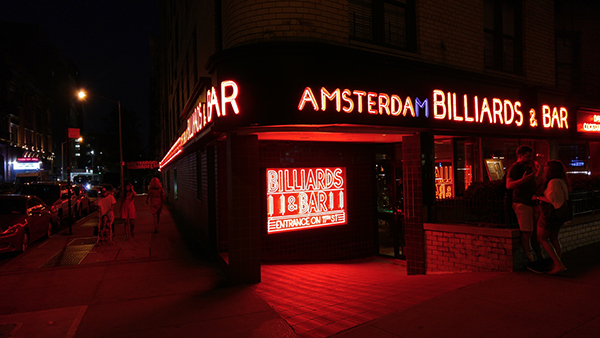
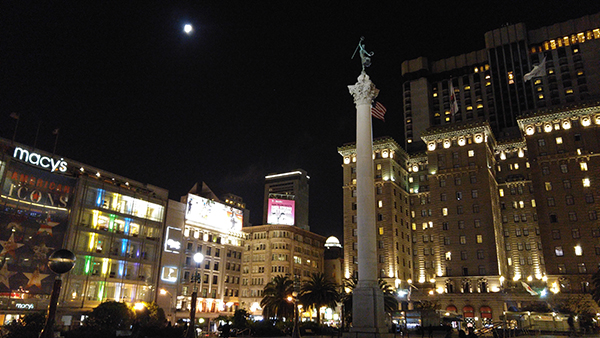
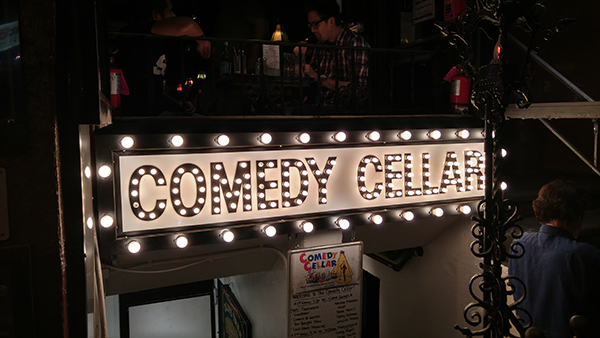
Full-Size Images: [G4: sample Hornet], [G4: sample Bakery], [G4: sample Golden Gate], [G4: sample Building], [G4: sample Car], [G4: sample Doors], [G4: sample Market], [G4: sample Street], [G4: sample Mural], [G4: sample Firehouse], [G4: sample Boats], [G4: sample Ship], [G4: sample Temple], [G4: sample Rose], [G4: sample Flower], [G4: sample Exposure], [G4: sample Sunset], [G4: sample Skyline], [G4: sample Billiards], [G4: sample Square], [G4: sample Comedy]
Most of these images were taken in auto mode, but some of the low-light shots used manual mode to control ISO.
Camera Performance
LG’s camera app launches very quickly, almost as fast as the camera on Samsung’s Galaxy S6 at around 1.5 seconds. Like the S6, the G4 preloads the camera app when the phone boots and leaves it running in the background. Force closing the camera app does not actually do anything; the G4 simply ignores the command and keeps the camera resident in RAM. This trick also enables the G4’s optional camera quick-launch feature that opens the camera app and can instantly snap a picture by pressing the volume down button twice from a locked screen, impressively, all in around two seconds.
Image capture is also speedy, noticeably faster than the G3 and similar to the Galaxy S6. Shot-to-shot latency hovers around one second, with the G4 and S6 taking turns at being the fastest to snap a picture. In burst mode the G4 takes about five shots per second at 16 MP compared to ~15 shots per second for the S6. The G4 also takes about two to three seconds to capture an HDR image depending on the lighting conditions, just slightly, but noticeably, slower than the S6.
The G4’s autofocus performance is inconsistent. When the laser AF works, it works very well, focusing as quickly as the S6’s and iPhone’s phase detect AF. However, the laser has trouble tracking moving objects and fails to work in some situations outdoors. The laser can also be overpowered by bright light sources. In these situations, the G4 falls back to the much slower contrast detect AF. There were also several times that the autofocus could not lock onto an object, forcing us to tap the subject on the screen or resulting in blurry images if we were less vigilant.
While they’re not perfect, the LG G4 comes with a great pair of cameras. The f/1.8 rear camera lens lets in more light, minimizing image noise and creating a nice bokeh effect for macro shots thanks to its decreased depth of field. Both cameras do a nice job setting exposure in auto mode, but the rear camera struggles with white balance. Despite the new color spectrum sensor, which was added to specifically improve color accuracy, the G4 tends to skew towards warmer colors. Fortunately, the deviation is usually mild.
Unlike the Galaxy S6, the G4 performs software-based noise reduction, which can degrade sharpness and detail slightly in well-lit shots. In low light, however, the G4’s noise reduction—the best we’ve seen—does an excellent job smoothing over noise grain while preserving fine details. It’s interesting that in the G4’s excellent manual camera mode the noise reduction algorithm is turned off.
Based on our side-by-side photo comparisons, the G4 comes in a close second to the Galaxy S6 (using the Sony IMX240 Exmor RS sensor and not the Samsung ISOCELL sensor) in terms of both camera performance and image quality. This is true in HDR mode too, where the S6 produces better results and employs it more often in auto mode. The G4’s auto HDR mode uses the effect far less frequently, negating its benefits in many situations. To effectively use HDR on the G4, you need to manually turn it on rather than rely on the auto HDR setting. Video performance is also good, but once again falls just behind the Galaxy S6.